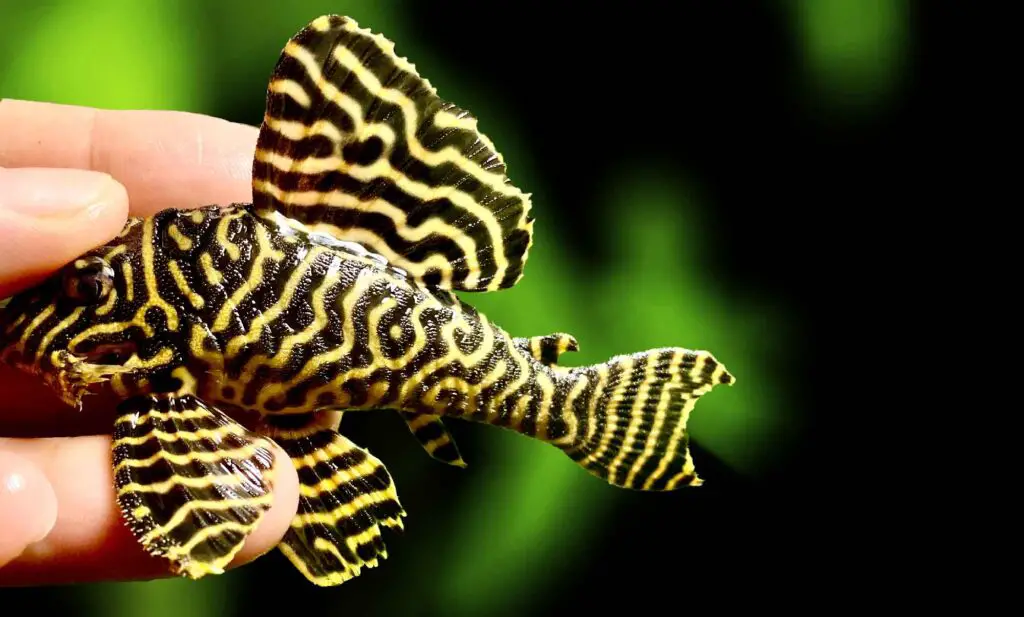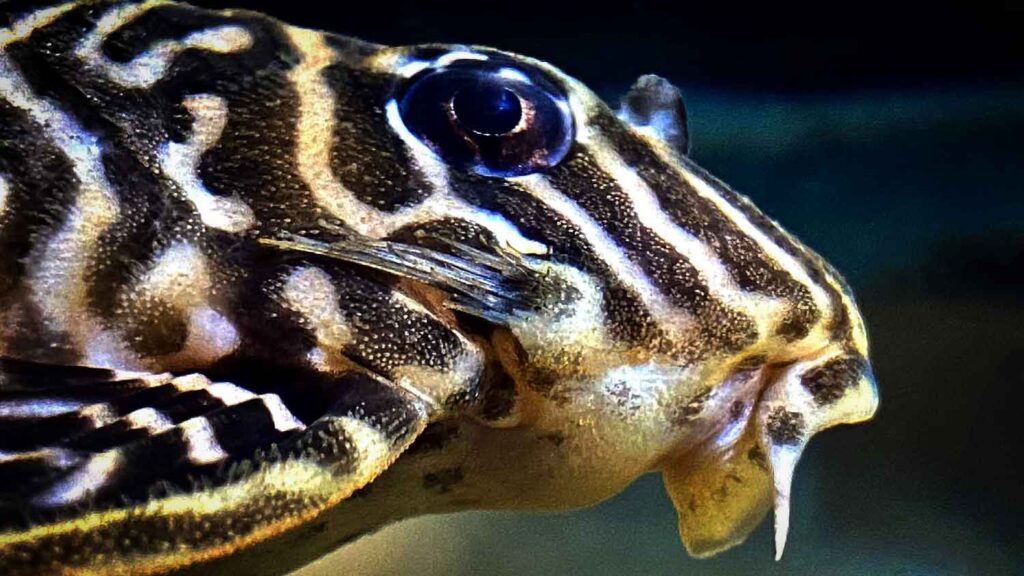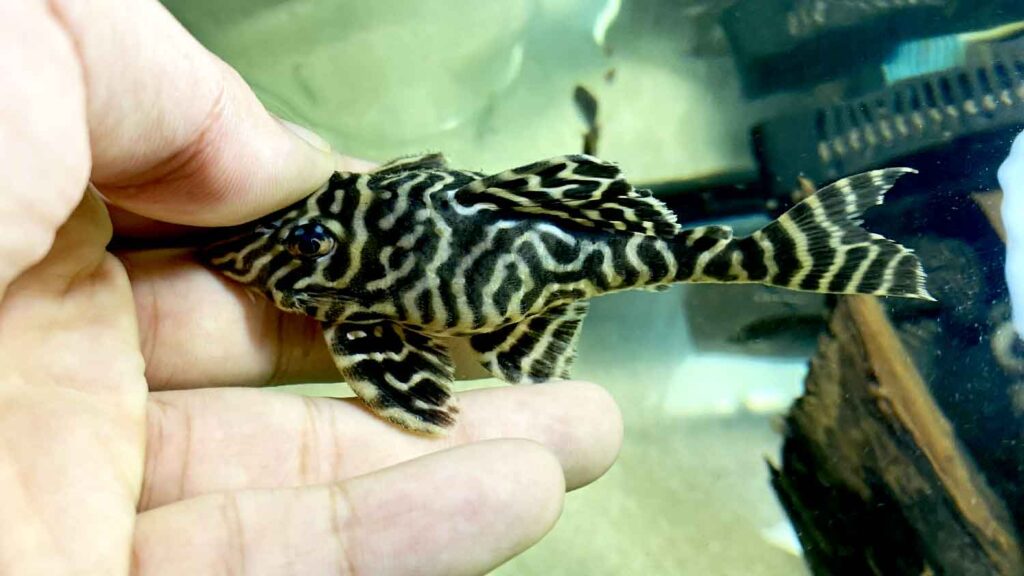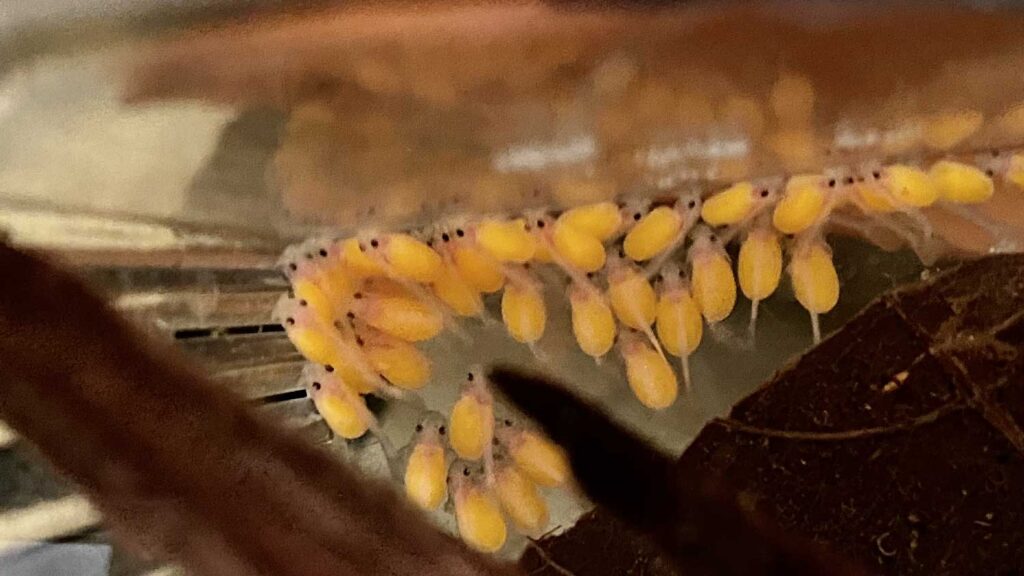The King Tiger Pleco, Hypancistrus sp. (L333), is one of our favorite freshwater fish that brings a different look to the tank. They bring both beauty and functionality to the tank. This bottom-dwelling fish will constantly search in the tank for any leftover food which will keep your tank healthy. It’s always nice to have a little extra help in maintaining the tank clean! L333 are also very easygoing and friendly fish that can live in any community tank. Given the right conditions, they will not bother other fish in the tank.
This article will walk you through all the information you need to know about King Tiger Pleco care and many more tips and tricks to make an ideal living space for them.
Species Profile & Overview
The King Tiger Pleco ( L333 ) is, by far, one of the most beautiful members of the Loricariidae family (plecos) native to Rio Xingu in the lower Amazon River in Brazil. These fish share the same body shape as other members of the family but have different colors and patterns.
This pleco goes by multiple names. You might see it called a “King Tiger Pleco” or referred to by their L-number, “L333”. They have a flat belly and are coated with bony plates on their back that will protect them from predators.
L333 Pleco lives in Xingu (Shin-Gu) River that has less driftwood, and fallen trees. This river mainly has sandy substrate and has clear water. There are many rocks and boulders in the river that plecos use to hide under, eat, breed and raise their fry. King Tiger Pleco are constantly forging in the water for a perfect hiding spot that will also provide them with enough food to eat.
These vibrant fish can easily live in your tank when you make a few adjustments. Unlike some kinds of plecos, the L333 will only grow to a fairly manageable size which makes them an ideal sucker-mouth catfish for most aquariums.
Appearance:

As mentioned, King Tiger Pleco are beautiful freshwater creatures from the Loricariidae family. Like all other fish in this family, they have armored backs and soft bellies.
The King Tiger Pleco is a copy cut of the known pleco mold. They have a thin and round body shape where it gets bold in the belly and slowly narrows towards the tail. They have a bony back that protects them from other predators. Unlike their back, their belly is soft with thin skin.
Eyes are on top of the head where they can have a wide view of their surroundings. Like most bottom-feeder fish, their moth is under the body.

L333 have 8 fins in total, the dorsal fin and tail fin are the biggest fins on their body. Fins usually have the same patterns and color as the rest of the body but are semi-transparent.
They have unique markings and colors that make them stay apart from other Loricariidae fish. Their black and yellowish white strips are not uniform but they have good contrast. These markings are mainly on the back and fins but the belly area is usually light yellow with no visible patterns.
Overall these fish are extremely beautiful and will make a great pet fish that will live for a long time.
Adult Size
The average King Tiger Pleco size is about 5 – 6 inches . Males tend to get slightly bigger and bulkier than females.
When you first buy this pleco it might be very small. That’s because most exporters ship smaller fish to save on shipping costs. They try to send as many fish in a bag as they can. These fish are slow growing and might take years for them to fully grow to their max size.
Lifespan
L333 Pleco lifespan is about 10-15 years. Under the right conditions, they will live even longer.
They reach this age only if they get a proper diet and care. Poor diet, water conditions, and sicknesses will drastically reduce the age of the fish.

Behavior and Temperament
King Tiger Plecos are relatively peaceful nocturnal fish. However, this does not mean that they will not swim around in the daytime. These fish will mainly come out to scavenge for food during the night.
However, this doesn’t mean that this fish is not coming out in the daytime. There are times when you see your fish swimming around in the fish tank and exploring the side glasses. This usually happens when the fish feels safe in the aquarium; which is a very good sign!
These fish might fight over territory and caves with other bottom-dweller fish in the aquarium. Males get more aggressive when other fish come close to their caves or favorite hiding spot.
In order to prevent this aggressive behavior, you will need to provide them with a large tank or just move some of the males to another tank. Provide lots of hiding spots in your tank so each pleco can have a space to hide. Adding a cave for each male is another way to house more plecos peacefully in a tank.
King Tiger Pleco Care
King Tiger Pleco care is simple and not complex at all. Most aquarium owners can keep this fish when they provide the right conditions.
That said, this hardy fish still needs a special environment to thrive. They have unique care needs and a special diet you will need to know. Clean and warm water as well as a diet that matches what they get in the wild is very important.
Here are some care tips you can follow to keep your L333 happy and healthy.
Tank Size
The minimum tank size for a single adult King Tiger Pleco is 30 gallons. We believe this fish needs enough space to thrive. Some might say they can live in smaller tanks, but we think anything less than a 30 gallon aquarium is not an ideal space for this fish.
If you are planning to keep more than one L333 plecos, then you should get even a bigger tank. They need a lot of bottom space so the gallon that your aquarium can hold might not always be the best way to calculate how many plecos you can keep in your tank.
The ideal tank for plecos is an aquarium that is wide and long. The height of the tank doesn’t matter that much. When you have a tank that is wide at the bottom you can have more plecos living in it. You can also create more floor surfaces in your aquarium by placing slates or tiles.

Tank Setup:
Recreating the natural habitat of King Tiger Pleco is crucial for its health and comfort. The rivers these fish are coming from are filled with boulders, rocks, and soft substrate. creating this environment will make your fish feel at home and safe.
The King Tiger Pleco needs a lot of hiding spaces in the tank. You can simply add lots of driftwood and rocks to your tank to create more hiding spots. You will also need to add pleco caves so they can have a safe place to rest during the day. You can make your own caves out of driftwood, or PVC pipes, or simply buy commercially made pleco caves. The commercially made pleco caves are the best option as they are designed specifically for this fish.
Plecos have soft bellies and almost always are sitting on their belly. Having rough or sharp substrate will eventually lead to cuts and infections. To avoid this you will need to use sand substrate or any of the softer planted tank substrates. Small pea gravels are also another option we use in some of our pleco tanks.
Additionally, we highly recommend adding live plants to your aquarium. Live plants are necessary for a healthy setup and can help in removing the aquarium of harmful substances. Your fish will also have several natural hiding spots among the plants’ leaves. You can use floating plants or any other live aquarium plant to enhance the appearance and water quality of your aquarium.
Water Parameters:
Keeping your tank’s parameters stable is the key for keeping King Tiger Pleco healthy. Stable water parameters are crucially important to the health of this fish. In the wild, these fish have well-oxygenated warm waters that have very low TDS. This means you will also need to create a similar environment in your aquarium. Below are the range you can keep L333 plecos in:
Temperature: 80 – 86 Degrees Fahrenheit
PH: 6.5 – 7
TDS: 60 – 120 PPM
A regular water change schedule is very important to make sure the parameters and general conditions of your aquarium stay stable. While the parameters above are super important, a stable aquarium is even more important to keep plecos healthy. So if your tap water PH and TDS is slightly different it’s still fine as long as you regularly do your water changes.

Lighting:
King Tiger Pleco does better in shades which means you should not use strong lights if you don’t have live plants. However, if you keep live plants, you can simply add more caves and hiding spots for them to hide during the time aquarium lights are on.
Filter System:
When selecting a filter, we strongly recommend getting the largest filter you can afford. King Tiger Pleco, produces a considerable amount of waste so a large filter is necessary to manage waste and prevent ammonia spikes in the aquarium.
Common Diseases and Prevention
Despite being hardy, the King Tiger Pleco is at risk of becoming ill from all common aquarium diseases. Your fish are living in a tiny ecosystem called an aquarium. This means diseases will easily and rapidly transmit among the fish.
You will need to clean the tank regularly and keep an eye on the water parameters. Never leave any uneaten food in the tank to rot and never add new fish to your tank without properly quarantining them. Regular water changes and good food will prevent many of the diseases aquarium fish might get. Prevention is the best cure!
Diet and Feeding Requirements
King Tiger Pleco are carnivores (meat-eaters) but will also eat algae, plant matter, fresh vegetables, and small microorganisms. Meaty foods are the main part of their diet. You can prepare your own food or feed them different types of frozen foods available online and in pet stores.
They prefer live foods over prepared food, but live food might not be available or a cheap option to source. You can feed your fish live foods such as bloodworms, brine shrimp, daphnia, and other small live foods available in pet stores. If live food is not available, you can feed your plecos frozen foods that are widely available in most pet stores and online.
There are also many commercially prepared foods available that are specifically made for plecos. When feeding commercially prepared foods, always get multiple different types and feed your fish a mix of all. High-protein fish flakes or pellets mixed with a low amount of high-fiber plant food are a good mix to feed.
Dry sinking foods should be the main food your King Tiger Pleco gets daily. Live and frozen foods are also great food sources that can be given 2-3 times per week. The King Tiger Pleco (L333) are active at night so you will need to feed them at night or when the lights are off. Always feed enough that they can eat in a few hours.
Breeding King Tiger Pleco

Breeding King Tiger Pleco is a delicate and sometimes frustrating process. Breeding L333 can be done in aquariums when the conditions are right.
In order to breed these fish, you will need your L333 to be mature and at least 2-3 years old. Once you confirm you have at least one male and one female in your breeding group, you can start to condition your fish for breeding.
If you have more males in your aquarium, then make sure that each male has a cave available in the aquarium for them. The rule of thumb is to add at least one cave per each male if not more.
L333 are cave breeders which means they need caves to breed. The cave should be slightly bigger than the male’s body; but, small enough that he can trap the female inside.
For breeding purposes, the male looks around for a suitable cave to trap the female in. When the male finds a suitable cave, he will clean it out and wait for the female to arrive. The male will then trap the female and will not let her leave the cave until she lays eggs.
Females lay about 40-60 eggs each time they breed.
Once eggs are laid, the male will let the female leave the cave, and then he will fertilize the eggs. It’s the male job to guard the eggs until they hatch. During this time, the male cleans the eggs and fans them so the eggs don’t go bad or get mold.
The eggs usually hatch 7-10 days after being laid.
After hatching, the fry usually stay at the back of the cave and feed on their egg sacks for the next few days. The male will keep the fry in the cave for another 7-10 days until they are fully developed and ready to leave.
Once the fry are strong enough, they will escape the cave and will attach to driftwood or glass in the aquarium. The fry usually stays together in a cluster in a single spot until they grow to half an inch in length.
Tank Mates
Selecting tank mates for your King Tiger Pleco isn’t hard at all. These fish are very passive and will live at the bottom of the aquarium. This means they will not clash with any of the water column fish. The only time that you might see aggressive behavior is if you house multiple bottom dweller fish in a tank that doesn’t have enough space.
This aggressive behavior is more common among males than females, but it can be easily avoided by setting up the aquarium correctly.
Any fish that can’t handle the water parameters of the King Tiger Pleco should be avoided. Most South American fish can make excellent tank mates, however, you will need to avoid large or aggressive fish. Most aggressive or large fish will try to bully your L333 pleco, and if it fits in their mouth they might even try to eat your pleco. To help get you started, here are some tank mate ideas for King Tiger Pleco:
- Angelfish
- Apistogramma
- Discus
- Harlequin Rasbora
- Cardinal Tetra
- Ember Tetra
- Other Tetras
- Other Plecos

Conclusion
If you can create a healthy environment, as mentioned in this article, for King Tiger Pleco (L333) then you should definitely add one to your aquarium. Always make sure you have enough space in the aquarium for the amount of fish you keep. Only add fishes that require the same conditions and diet pet pleco. Doing this will provide a healthy habitat for your pleco and their tank mates.
Congratulations! Now you know everything about L333 King Tiger Pleco care and you can confidently own one!